
Question Number 213250 by ajfour last updated on 01/Nov/24
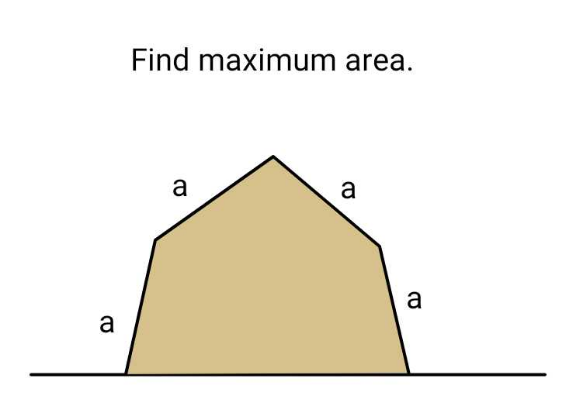
Answered by a.lgnaoui last updated on 02/Nov/24
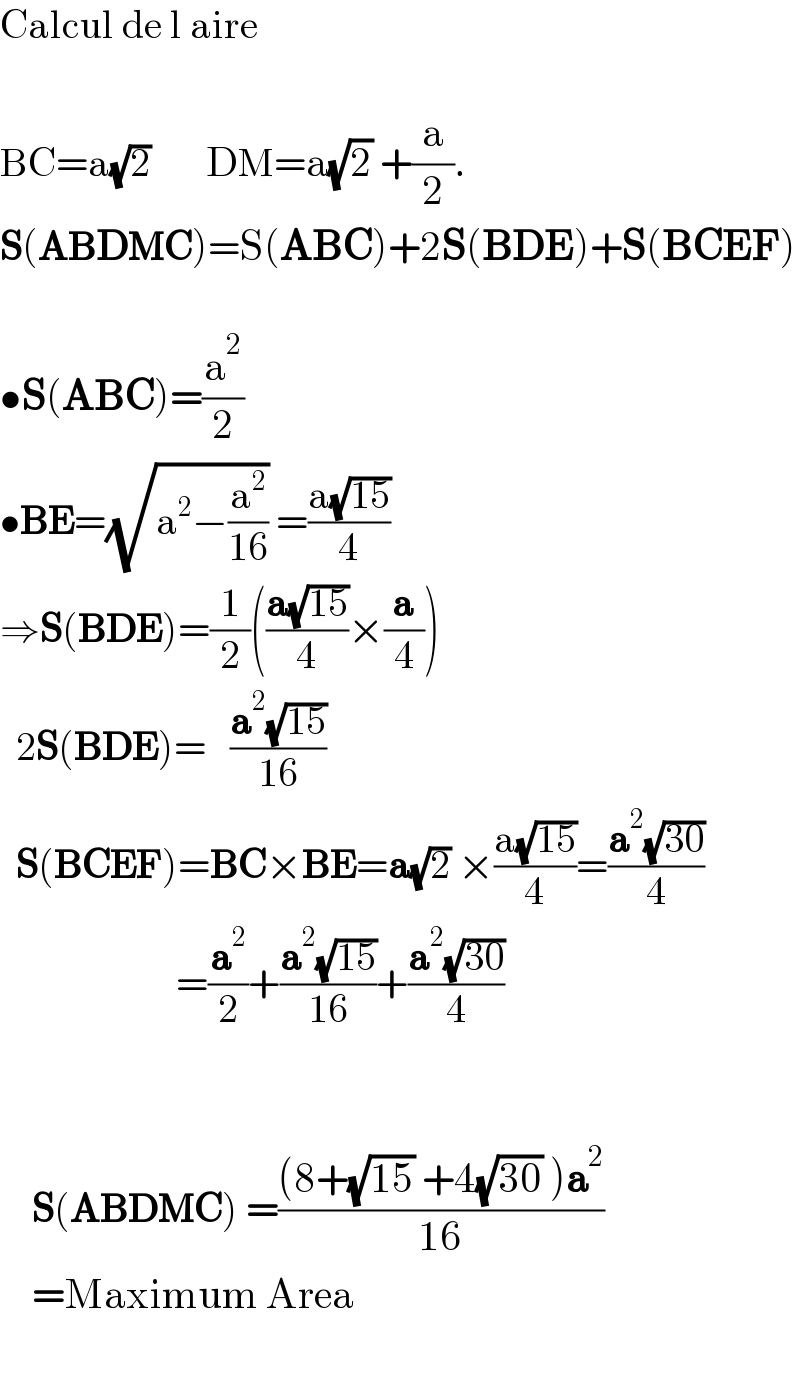
$$\mathrm{Calcul}\:\mathrm{de}\:\mathrm{l}\:\mathrm{aire} \\ $$$$ \\ $$$$\mathrm{BC}=\mathrm{a}\sqrt{\mathrm{2}}\:\:\:\:\:\:\:\mathrm{DM}=\mathrm{a}\sqrt{\mathrm{2}}\:+\frac{\mathrm{a}}{\mathrm{2}}. \\ $$$$\boldsymbol{\mathrm{S}}\left(\boldsymbol{\mathrm{ABDMC}}\right)=\mathrm{S}\left(\boldsymbol{\mathrm{ABC}}\right)+\mathrm{2}\boldsymbol{\mathrm{S}}\left(\boldsymbol{\mathrm{BDE}}\right)+\boldsymbol{\mathrm{S}}\left(\boldsymbol{\mathrm{BCEF}}\right) \\ $$$$ \\ $$$$\bullet\boldsymbol{\mathrm{S}}\left(\boldsymbol{\mathrm{ABC}}\right)=\frac{\mathrm{a}^{\mathrm{2}} }{\mathrm{2}}\:\:\:\:\:\:\: \\ $$$$\bullet\boldsymbol{\mathrm{BE}}=\sqrt{\mathrm{a}^{\mathrm{2}} −\frac{\mathrm{a}^{\mathrm{2}} }{\mathrm{16}}}\:=\frac{\mathrm{a}\sqrt{\mathrm{15}}}{\mathrm{4}} \\ $$$$\Rightarrow\boldsymbol{\mathrm{S}}\left(\boldsymbol{\mathrm{BDE}}\right)=\frac{\mathrm{1}}{\mathrm{2}}\left(\frac{\boldsymbol{\mathrm{a}}\sqrt{\mathrm{15}}}{\mathrm{4}}×\frac{\boldsymbol{\mathrm{a}}}{\mathrm{4}}\right) \\ $$$$\:\:\mathrm{2}\boldsymbol{\mathrm{S}}\left(\boldsymbol{\mathrm{BDE}}\right)=\:\:\:\frac{\boldsymbol{\mathrm{a}}^{\mathrm{2}} \sqrt{\mathrm{15}}}{\mathrm{16}} \\ $$$$\:\:\boldsymbol{\mathrm{S}}\left(\boldsymbol{\mathrm{BCEF}}\right)=\boldsymbol{\mathrm{BC}}×\boldsymbol{\mathrm{BE}}=\boldsymbol{\mathrm{a}}\sqrt{\mathrm{2}}\:×\frac{\mathrm{a}\sqrt{\mathrm{15}}}{\mathrm{4}}=\frac{\boldsymbol{\mathrm{a}}^{\mathrm{2}} \sqrt{\mathrm{30}}}{\mathrm{4}} \\ $$$$\:\:\:\:\:\:\:\:\:\:\:\:\:\:\:\:\:\:\:\:\:\:=\frac{\boldsymbol{\mathrm{a}}^{\mathrm{2}} }{\mathrm{2}}+\frac{\boldsymbol{\mathrm{a}}^{\mathrm{2}} \sqrt{\mathrm{15}}}{\mathrm{16}}+\frac{\boldsymbol{\mathrm{a}}^{\mathrm{2}} \sqrt{\mathrm{30}}}{\mathrm{4}} \\ $$$$ \\ $$$$ \\ $$$$\:\:\:\:\boldsymbol{\mathrm{S}}\left(\boldsymbol{\mathrm{ABDMC}}\right)\:=\frac{\left(\mathrm{8}+\sqrt{\mathrm{15}}\:+\mathrm{4}\sqrt{\mathrm{30}}\:\right)\boldsymbol{\mathrm{a}}^{\mathrm{2}} }{\mathrm{16}} \\ $$$$\:\:\:\:=\mathrm{Maximum}\:\mathrm{Area} \\ $$$$\:\:\:\:\:\:\: \\ $$
Commented by a.lgnaoui last updated on 02/Nov/24
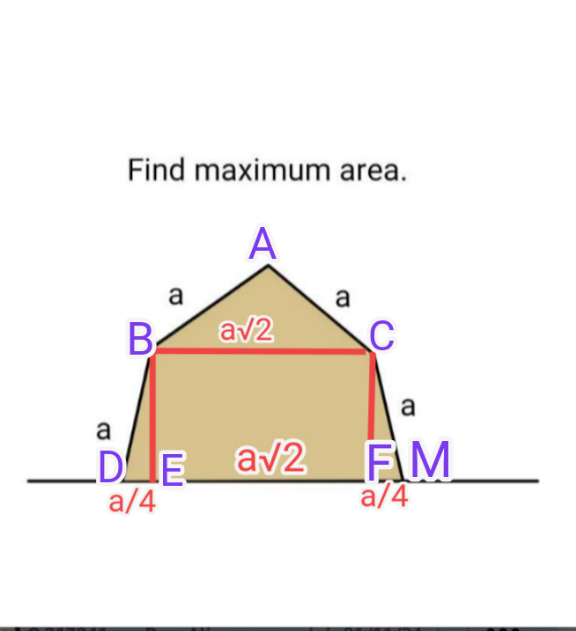
Commented by mr W last updated on 02/Nov/24

$${you}\:{can}\:{not}\:{take}\:{an}\:{angle}\:{as}\:{a}\:{right} \\ $$$${angle}\:{just}\:{because}\:{it}\:{looks}\:{like}\:{a} \\ $$$${right}\:{angle}\:{in}\:{the}\:{sketch}.\:{this}\:{is}\: \\ $$$${basic}! \\ $$
Answered by Frix last updated on 02/Nov/24
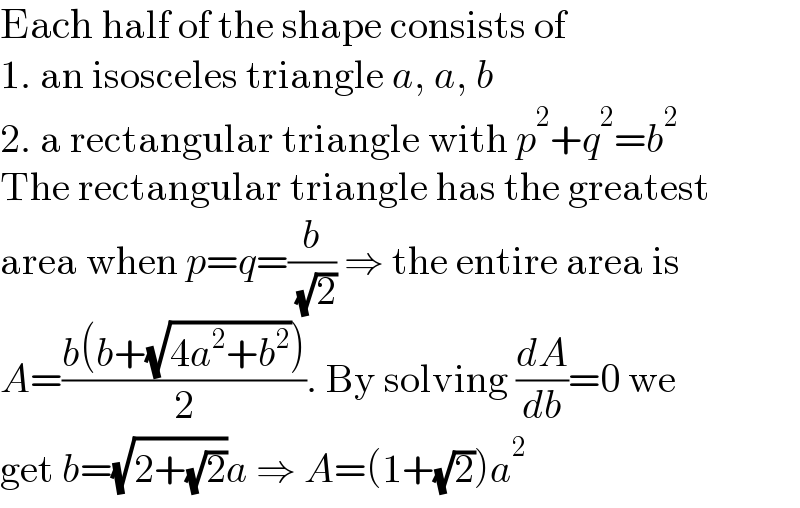
$$\mathrm{Each}\:\mathrm{half}\:\mathrm{of}\:\mathrm{the}\:\mathrm{shape}\:\mathrm{consists}\:\mathrm{of} \\ $$$$\mathrm{1}.\:\mathrm{an}\:\mathrm{isosceles}\:\mathrm{triangle}\:{a},\:{a},\:{b} \\ $$$$\mathrm{2}.\:\mathrm{a}\:\mathrm{rectangular}\:\mathrm{triangle}\:\mathrm{with}\:{p}^{\mathrm{2}} +{q}^{\mathrm{2}} ={b}^{\mathrm{2}} \\ $$$$\mathrm{The}\:\mathrm{rectangular}\:\mathrm{triangle}\:\mathrm{has}\:\mathrm{the}\:\mathrm{greatest} \\ $$$$\mathrm{area}\:\mathrm{when}\:{p}={q}=\frac{{b}}{\:\sqrt{\mathrm{2}}}\:\Rightarrow\:\mathrm{the}\:\mathrm{entire}\:\mathrm{area}\:\mathrm{is} \\ $$$${A}=\frac{{b}\left({b}+\sqrt{\mathrm{4}{a}^{\mathrm{2}} +{b}^{\mathrm{2}} }\right)}{\mathrm{2}}.\:\mathrm{By}\:\mathrm{solving}\:\frac{{dA}}{{db}}=\mathrm{0}\:\mathrm{we} \\ $$$$\mathrm{get}\:{b}=\sqrt{\mathrm{2}+\sqrt{\mathrm{2}}}{a}\:\Rightarrow\:{A}=\left(\mathrm{1}+\sqrt{\mathrm{2}}\right){a}^{\mathrm{2}} \\ $$
Commented by ajfour last updated on 02/Nov/24

$${very}\:{straight}\:{and}\:{precise}!\:{i}\:{like}\:{it}. \\ $$
Commented by Frix last updated on 02/Nov/24

$$\mathrm{Thank}\:\mathrm{you} \\ $$
Answered by mr W last updated on 02/Nov/24
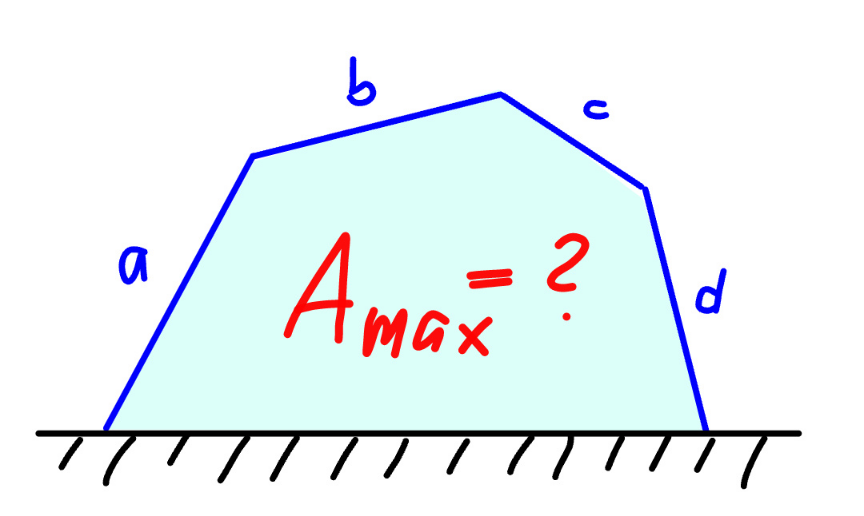
Commented by mr W last updated on 02/Nov/24
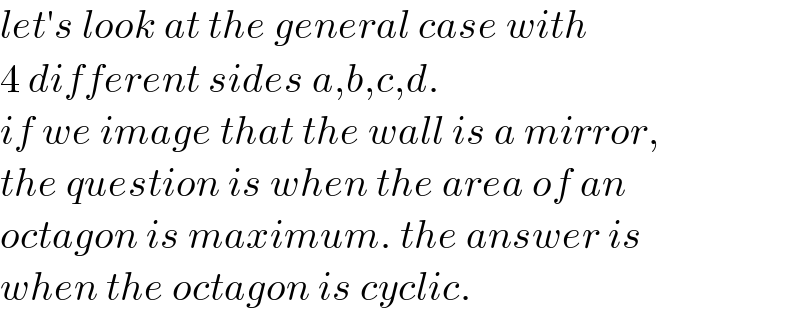
$${let}'{s}\:{look}\:{at}\:{the}\:{general}\:{case}\:{with} \\ $$$$\mathrm{4}\:{different}\:{sides}\:{a},{b},{c},{d}. \\ $$$${if}\:{we}\:{image}\:{that}\:{the}\:{wall}\:{is}\:{a}\:{mirror}, \\ $$$${the}\:{question}\:{is}\:{when}\:{the}\:{area}\:{of}\:{an} \\ $$$${octagon}\:{is}\:{maximum}.\:{the}\:{answer}\:{is} \\ $$$${when}\:{the}\:{octagon}\:{is}\:{cyclic}. \\ $$
Commented by mr W last updated on 02/Nov/24
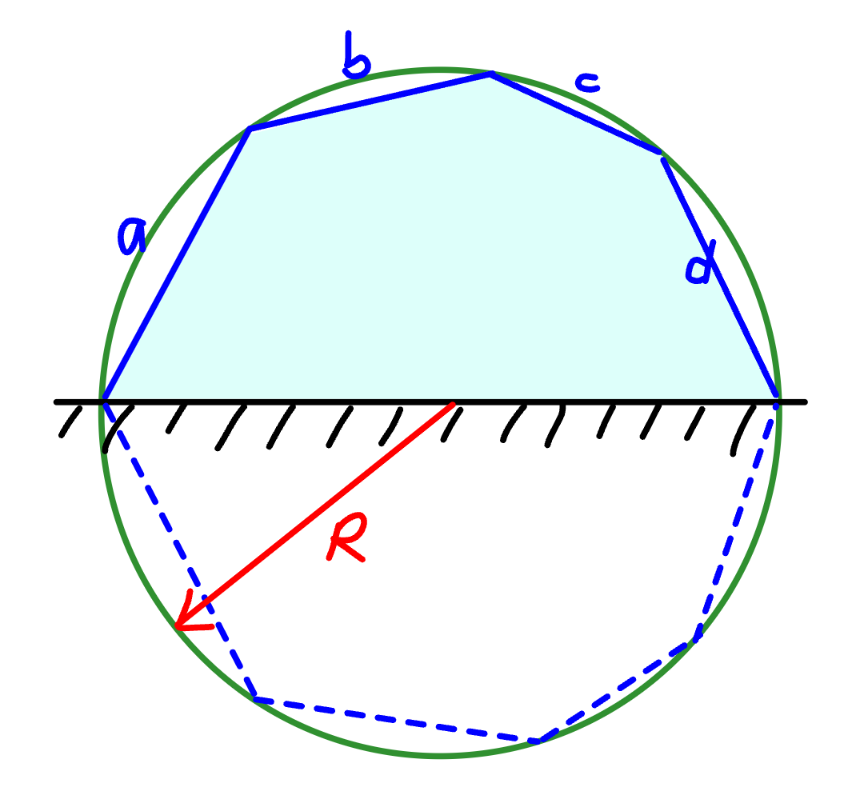
Commented by mr W last updated on 02/Nov/24
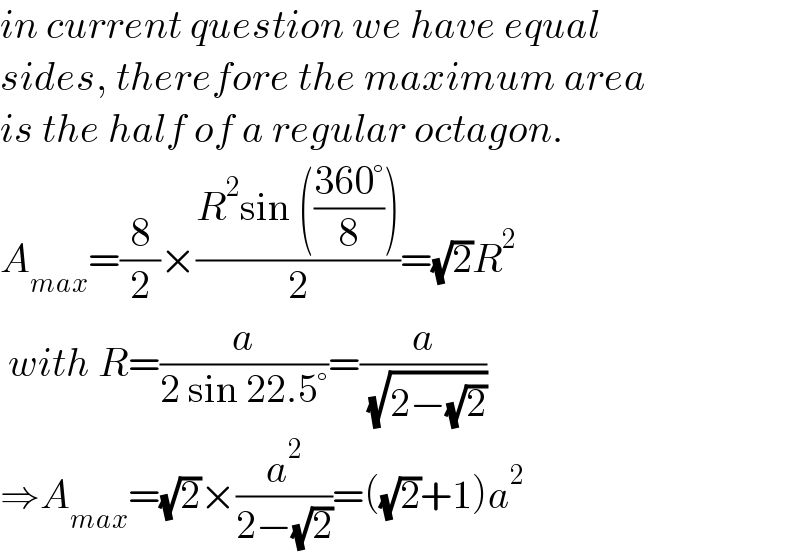
$${in}\:{current}\:{question}\:{we}\:{have}\:{equal} \\ $$$${sides},\:{therefore}\:{the}\:{maximum}\:{area} \\ $$$${is}\:{the}\:{half}\:{of}\:{a}\:{regular}\:{octagon}. \\ $$$${A}_{{max}} =\frac{\mathrm{8}}{\mathrm{2}}×\frac{{R}^{\mathrm{2}} \mathrm{sin}\:\left(\frac{\mathrm{360}°}{\mathrm{8}}\right)}{\mathrm{2}}=\sqrt{\mathrm{2}}{R}^{\mathrm{2}} \\ $$$$\:{with}\:{R}=\frac{{a}}{\mathrm{2}\:\mathrm{sin}\:\mathrm{22}.\mathrm{5}°}=\frac{{a}}{\:\sqrt{\mathrm{2}−\sqrt{\mathrm{2}}}} \\ $$$$\Rightarrow{A}_{{max}} =\sqrt{\mathrm{2}}×\frac{{a}^{\mathrm{2}} }{\mathrm{2}−\sqrt{\mathrm{2}}}=\left(\sqrt{\mathrm{2}}+\mathrm{1}\right){a}^{\mathrm{2}} \\ $$
Commented by ajfour last updated on 02/Nov/24

$${Utter}\:{well}\:{thought}! \\ $$
